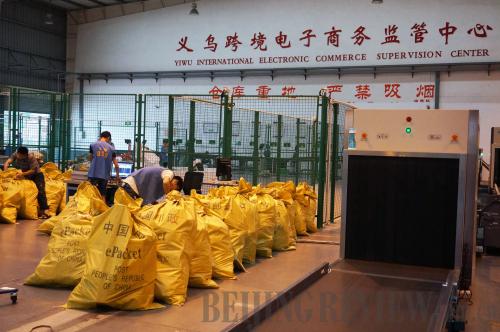
Workers clear up packages of small commodities ready for export customs clearance at Yiwu Cross-Border E-commerce Supervision Center in Yiwu, Zhejiang Province, on June 3 (XINHUA)
Livelihood boosted
The gear shift of China's economy doesn't necessarily mean people's livelihood will be affected. In the first half of 2015, the per-capita disposable income of urban residents totaled 10,931 yuan ($1,760), scoring a growth of 7.6 percent in real terms, outstripping the GDP growth. "It, to some extent, reflects structural adjustments and measures targeted at enhancing people's living standards have yielded some results," Cao Heping, a professor from the School of Economics of Peking University, told China News Service.
In recent years, the service industry has witnessed leapfrog expansion, which has provided many employment opportunities and well-paid jobs. The rise of minimum wage in many areas also helps boost the earnings of the low-income population, said Cao.
Meanwhile, the consumer price index (CPI) increased 1.3 percent in the first half, 0.1 percentage point higher than that in the first quarter, well within the whole-year control target of 3 percent.
In some sense, it was a result of a domestic economic slowdown, weak demand and price fall of major international commodities, said Cao, noting that the low price level means people can purchase more goods with the same amount of money.
Buoyant residents' income in combination with well controlled price level indicates that the economic stability has been strengthened and people's well-being been better secured, said Fan Jianping, chief economist of the SIC.
Aside from that, employment was better than expected. In the first half of the year, a total of 7.18 million urban jobs were created, accomplishing 71.8 percent of the full-year target, with the unemployment rate standing at roughly 5.1 percent, according to statistics from the NBS. Behind the propitious employment figures is the rapid development of the producer services industries, said Cao.
Under great downward pressures and amidst the profound adjustment of industrial structure, stable employment is a result of the government's endeavor to promote innovation and entrepreneurship and will ensure social stability, argued Cao.
Good prospects
The unfinished urbanization and industrialization along with the upgrade of consumption structure will continue to provide a growth impetus, and the efficacy of the newly released policies and measures will be further displayed in days to come, said Sheng.
The public-private partnership project library established by the National Development and Reform Commission in May has recruited 1,043 projects, with total investment amounting to 1.97 trillion yuan ($317.17 billion), and the capital approved in May alone exceeded 250 billion yuan ($40.25 billion). "It takes time for an approved project to be rendered into real investment and productivity," Sheng noted.
"Monetary and fiscal policies, as well as measures to revitalize the property market have not been fully exploited. Therefore, they will continue to fuel the economy in the second half year," said Zhu, who predicted investment, consumption and exports will perform better and play a stronger role in securing a 7-percent growth in the second half.
However, downward risks still persist. Further efforts should be made to stabilize the capital market, tackle overcapacity, bring down financing costs, push forward fiscal reforms and tax reforms as well as financial and state-owned enterprise reforms, and give full play to policies targeted at adjusting supply and demand, said Zhu.
Zhang Jun, head of the information department at the China Center for International Economic Exchanges, noted international factors such as the likely interest rate hike by the U.S. Federal Reserve and Greece's debt problem, as well as domestic factors like the volatile stock market and the deleveraging of enterprises may undermine the upward trend.
"In mid- and long-term, it's still an uphill battle for China to rebalance its economy. In the bottoming out process, uncertainties will rise. The government needs to prevent partial risks from evolving into regional or systematic risks," said Zhang.
Huang Yiping, a professor from the National School of Development of Peking University, argued the prospective rebound of China's economy depends on whether new mainstay industries could come into being through innovation, transformation and upgrades.
"Though the emerging growth engines are not strong enough to bolster the economy, these new industries, products and forms of business represent a hopeful direction for future development," said Huang.
















































